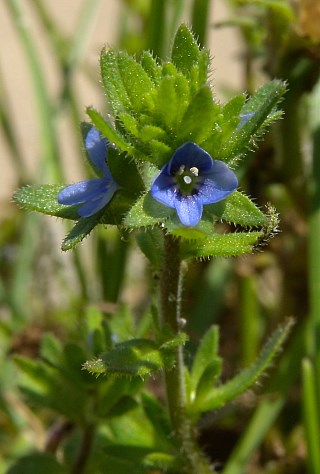 Description:
This
wildflower is a winter or spring annual that becomes 2-8" tall. It
often branches near the
base, but its stems are unbranched above. The slender stems are light
green and hairy. The lower leaves are up to 3/8" long and across; they
are yellowish
green to green, hairy, oval-orbicular, crenate along their margins, and
opposite. The petioles of the lower leaves are very short (about 1/8"
long). As a plant matures, there is a tendency for the lower leaves to
turn brown and wither away. The middle to upper leaves, where the
flowers develop, are up to ¼" long, linear-oblong to lanceolate in
shape, smooth or slightly crenate along their margins, sessile or
nearly so, and alternate. Like the lower leaves, they are yellowish
green to green and hairy. Solitary flowers develop from the axils of
the middle to upper alternate leaves. Each flower is 1/8" across,
consisting of a blue-violet to blue corolla with 4 petal-like lobes, 4
hairy green sepals, 2 stamens with white anthers, and a pistil with a
single style. The corolla usually has a few faint veins originating
from the center of the flower. The sepals are lanceolate-oblong and
somewhat longer than the corolla. The tiny flowers bloom near the apex
of the stems from mid-spring to mid-summer for 1-3 months. Each flower
is replaced by an obcordate (heart-shaped) seed capsule. Individual
seed capsules are 1/8" (3 mm.) long, 1/8" (3 mm.) across, somewhat
flattened, and
ciliate. Both the flowers and seed capsules are nearly sessile. Each
seed capsule is 2-celled and contains many tiny seeds. The root system
consists of a slender much-branched taproot. This wildflower reproduces
by reseeding itself and it occasionally forms colonies.
Description:
This
wildflower is a winter or spring annual that becomes 2-8" tall. It
often branches near the
base, but its stems are unbranched above. The slender stems are light
green and hairy. The lower leaves are up to 3/8" long and across; they
are yellowish
green to green, hairy, oval-orbicular, crenate along their margins, and
opposite. The petioles of the lower leaves are very short (about 1/8"
long). As a plant matures, there is a tendency for the lower leaves to
turn brown and wither away. The middle to upper leaves, where the
flowers develop, are up to ¼" long, linear-oblong to lanceolate in
shape, smooth or slightly crenate along their margins, sessile or
nearly so, and alternate. Like the lower leaves, they are yellowish
green to green and hairy. Solitary flowers develop from the axils of
the middle to upper alternate leaves. Each flower is 1/8" across,
consisting of a blue-violet to blue corolla with 4 petal-like lobes, 4
hairy green sepals, 2 stamens with white anthers, and a pistil with a
single style. The corolla usually has a few faint veins originating
from the center of the flower. The sepals are lanceolate-oblong and
somewhat longer than the corolla. The tiny flowers bloom near the apex
of the stems from mid-spring to mid-summer for 1-3 months. Each flower
is replaced by an obcordate (heart-shaped) seed capsule. Individual
seed capsules are 1/8" (3 mm.) long, 1/8" (3 mm.) across, somewhat
flattened, and
ciliate. Both the flowers and seed capsules are nearly sessile. Each
seed capsule is 2-celled and contains many tiny seeds. The root system
consists of a slender much-branched taproot. This wildflower reproduces
by reseeding itself and it occasionally forms colonies.
Cultivation:
The preference is full sun, mesic to dry-mesic conditions, and poor
soil where there is reduced competition from other plants. The soil can
contain sand, rocky material, loam, or clay.
Range & Habitat:
Corn Speedwell is quite common and it can be found in every county of
Illinois (see Distribution
Map). This little weed was introduced accidentally into North
America from
Europe. Habitats include scrubby savannas with sparse ground
vegetation, rocky glades, fields, lawns and gardens, grassy areas along
roads, and barren waste ground. Highly disturbed areas are preferred.
Faunal Associations:
Small bees and Syrphid flies suck nectar from the flowers. Charles
Robertson observed the Syrphid fly Toxomerus marginatus,
and the Halictid bees Augochlorella aurata and Lasioglossum
versatus visiting the flowers. However, floral visitors are
uncommon and the flowers are capable of self-fertilization. The stink
bug Cosmopepla lintneriana has been observed to
suck juices from the foliage of Corn Speedwell (as well as many other
plants).

Photographic
Location:
A lawn in Urbana, Illinois.
Comments:
Corn Speedwell is one of several annual Veronica spp.
(Speedwell species) that have been introduced from Europe. They are
usually very weedy species. Because Corn Speedwell is small and not
very showy, it is easy to overlook. The flowers are a lovely shade of
blue-violet or blue, but they are very small in size and short-lived.
Corn Speedwell can be distinguished from other similar species by its
nearly sessile flowers and seed capsules, and the narrow alternate
leaves (or leafy bracts) along the upper two-thirds of its stems. Its
flowers are usually a deeper shade of blue than those of similar
species. Another common name of Veronica arvensis
is Field Speedwell.